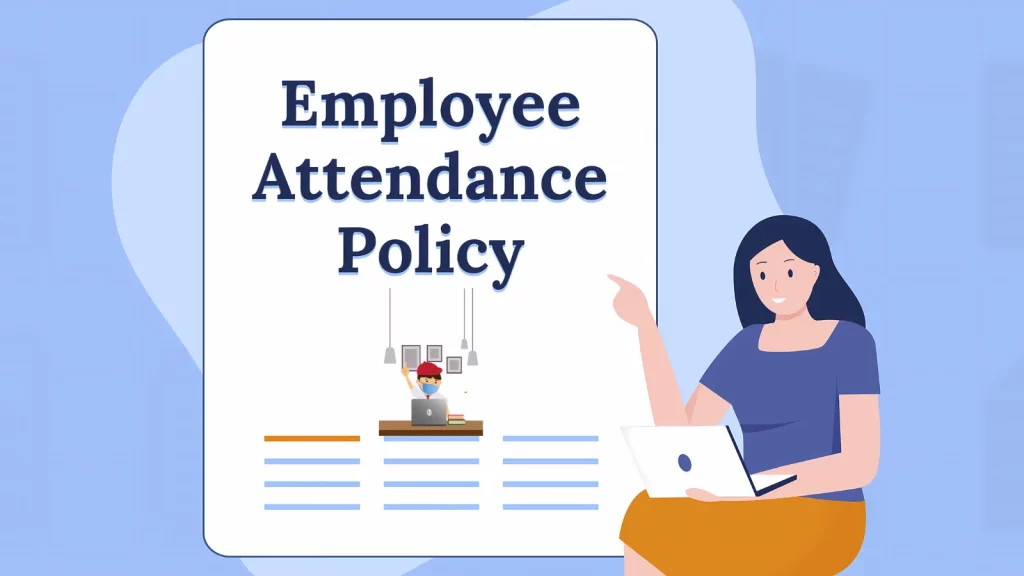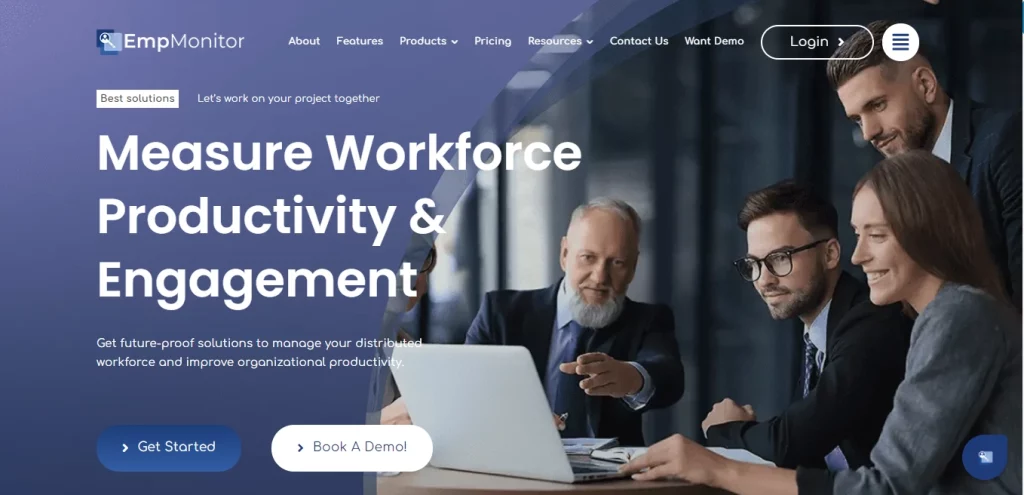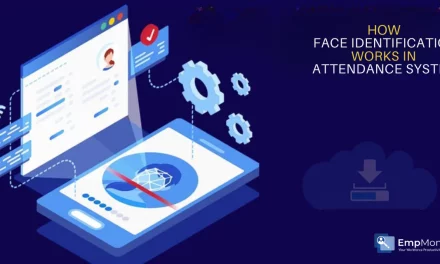Maintaining consistent and reliable employee attendance is the key to ensuring productivity and fostering a positive work environment. An effective employee attendance policy is a game-changer in managing workforce attendance, setting clear expectations, and addressing absenteeism proactively.
The attendance policy in an organization outlines the standards for punctuality and presence but also provides guidelines for leaves, handling tardiness, and managing unplanned absences.
By establishing transparent rules and procedures, employers can create a fair and motivating atmosphere where employees understand their responsibilities and the impact of their attendance on the team’s success.
In this blog, we delve into the essentials of crafting a robust employee attendance policy that balances organizational needs with employee well-being.
Listen To The Podcast Now!
What Is Attendance Policy?
What Is an Attendance Policy?
An Employee Attendance Policy is a formal document that outlines your organization’s expectations regarding employee attendance, absences, and punctuality. It provides a structured framework to ensure consistency and fairness in how attendance is managed across all departments. This policy defines what constitutes acceptable and unacceptable attendance behavior, including tardiness, planned leaves, and unexcused absences.
A well-defined Employee Attendance Policy serves as a vital part of a company’s overall HR structure. It helps managers and employees understand their responsibilities and ensures everyone adheres to the same attendance standards. The goal is to promote accountability, reduce absenteeism, and maintain a smooth workflow throughout the organization.
Typically, the Employee Attendance Policy is included in the employee handbook and communicated during onboarding to ensure clarity and transparency from day one. It should align with legal requirements, company culture, and any industry-specific compliance standards. By documenting these guidelines, employers can set clear expectations while also providing flexibility for genuine employee needs such as sick days, family emergencies, or approved leaves of absence.
Ultimately, an Employee Attendance Policy is more than just a rulebook—it’s a proactive tool that fosters discipline, builds trust, and supports a balanced work environment. When implemented effectively, it helps maintain productivity and track employee attendance while ensuring employees feel supported and respected in managing their time responsibly.
What Key Aspects Attendance Policy Should Cover?
An attendance policy is a set of guidelines established by an employer to manage and oversee employee attendance. Typically, such employee attendance policy covers several key areas:
Attendance Expectations: Defines when, where, and for how long you expect employees to be present and engaged in their job duties. It also specifies work hours and availability on company communication platforms for remote workers.
Punctuality Standards: Outlines the company’s stance on punctuality, including acceptable reasons for missed deadlines and the degree to which unpunctuality your organization tolerates. It clarifies if and how the organization applies penalties for late arrivals.
Penalties and Consequences: Penalties and consequences are outlined in attendance policies to ensure consistent adherence to attendance standards. By specifying repercussions like warnings or termination, organizations promote accountability, maintain operational efficiency, and uphold a fair working environment for all employees.
Allowable Absences: Explain the acceptable number of absences, late arrivals, and early departures before enforcing consequences.
Time Off Request Procedure: It includes a structured process for requesting time off, ensuring clarity and fairness.
Additionally, some attendance policies may specify how they record absences, the documentation required, and the notification procedures to follow.
What Should Employee Attendance Policy Have?
Crafting an effective employee attendance policy involves integrating several critical components, akin to assembling a cohesive puzzle. Together, these elements form a comprehensive framework that promotes fairness, enhances productivity, and cultivates a supportive workplace environment. Let’s delve into the key components that you may include:
Set Your Goal: Define key terms such as approved absences, unscheduled absences, tardiness, sick days, early departures, and job abandonment to eliminate ambiguity and ensure consistent understanding among employees.
Absence Reporting Procedures: Clearly outline how employees should report absences, including preferred communication channels and required information like reason and expected duration.
Consequences for Policy Violations: Specify outcomes for non-compliance, ensuring they are fair, consistent, and proportionate to the severity of the infraction.
Flexibility: Incorporate flexible attendance options in your employee attendance policy such as remote work or flexible hours to accommodate unforeseen circumstances and support work-life balance.
Employee Support: Demonstrate commitment to employee well-being by including resources like Employee Assistance Programs (EAPs) to assist employees facing personal or health-related challenges.
Accessibility and Accommodations: Ensure inclusivity by accommodating employees with disabilities or special needs, fostering an environment where everyone can thrive.
By integrating these components, your attendance policy ensures operational efficiency and promotes a workplace culture built on trust, understanding, and support for all employees. Taking a holistic approach contributes to employees’ satisfaction and the organization’s success.
How To Create An Employee Attendance Policy And Procedure?
The creation of an effective attendance workplace policy is crucial to maintaining organizational efficiency and employee accountability. Here is a detailed explanation of the steps involved in developing such a policy:
Step-1 Define the Purpose and Scope
Clearly state why the organization has created an attendance policy. Organizations can make policies to improve productivity, ensure fairness, or comply with legal requirements. Specify whether the policy applies to all employees or specific departments/job roles. It sets boundaries and clarifies who the policy impacts.
Step-2 Research Legal Requirements
Ensure compliance with local labor laws and regulations. Define maximum hours per day and week, break periods, and rest periods. Specify when overtime applies, how it’s calculated, and approval procedures. Include requirements for vacation, sick leave, parental leave, and other types of leave mandated by law. Incorporate these legal requirements into your employee attendance policy to avoid legal liabilities.
Step-3 Gather Stakeholder Input
Consult with key stakeholders such as HR professionals, managers, legal advisors, and employee representatives. Discuss attendance expectations, consequences for non-compliance, and any unique organizational considerations that should be addressed in the policy.
Step-4 Set Clear Working Hours
Define standard working hours, including start and end times for each workday, and specify break periods. This clarity helps in managing employee schedules and ensures consistency across the organization.
Step-5 Define Attendance Expectations
Communicate expectations regarding regular attendance and punctuality. Define what constitutes tardiness, early departures, and extended breaks.
Establishing clear expectations helps employees understand what is expected of them regarding attendance.
Step-6 Address Time-Off and Leave Policies
Outline procedures for requesting time off, including how requests should be submitted, advance notice requirements, and any documentation needed (e.g., medical certificates) in your employee attendance policy. Clarify different types of available leave (vacation, sick, personal leave) and eligibility criteria.
Taking the help of a versatile tool, like EmpMonitor can help you track and manage these requests efficiently by streamlining the submission and approval process, ensuring requests are logged accurately, and providing a centralized platform for tracking leave balances and compliance with company policies.
Step-7 Specify Overtime Policies
If applicable, define how overtime is determined when it is allowed, and outline the process for obtaining approval before working overtime hours, in accordance with the time and attendance policy. This ensures transparency and compliance with labor laws regarding overtime pay and limits.
Step-8 Detail Consequences for Tardiness and Absenteeism
State penalties for repeated tardiness or unexcused absences like verbal warnings, written warnings, or progressive disciplinary actions in the employee attendance policy. Set up consequences, it helps employees follow attendance rules and take responsibility. This helps reduce excessive absenteeism at work.
Step-9 Clarify Reporting Procedures
Provide instructions on how employees should report absences or late arrivals, including preferred methods of communication (phone call, email, etc.) and who to notify. It ensures that absences are properly documented and managed.
Step-10 Provide Examples and Scenarios
Include practical examples or scenarios that illustrate how the attendance policy applies in various situations (e.g., requesting time off, handling emergencies). Attendance policy examples help employees understand policy applications and make compliance expectations clearer.
Step-11 Educate Employees
Conduct training sessions or informational meetings to introduce the new attendance policy to employees. Ensure employees understand the policy, its importance, and where to find the policy document for reference.
Step-12 Review and Update Regularly
Keep the employee attendance policy up-to-date and effective by reviewing it regularly. Update the policy as needed to reflect changes in organizational needs, legal requirements, or industry standards. Communicate updates to employees promptly to keep them informed and compliant.
By following these steps, organizations can develop a comprehensive Attendance Policy template that supports operational efficiency, legal compliance, and a positive workplace culture centered around accountability and fairness. Here is an example of a employee attendance policy template-
Implement robust time-tracking practices to enhance productivity. You can take advantage of software like EmpMonitor. EmpMonitor is a comprehensive workforce management software that fosters a transparent work environment. With this software organizations can seamlessly integrate time tracking into their attendance policy, ensuring compliance and promoting a fair workplace for all employees.
How Does EmpMonitor Help In Time Tracking?
EmpMonitor is a comprehensive workforce management and employee monitoring software that offers several features that are beneficial for implementing and enforcing an employee attendance policy. It empowers businesses to manage resources and enhance overall performance, contributing to sustained growth and success in today’s evolving work environment.
Here’s an explanation of EmpMonitor along with its relevant features:
Attendance Tracking
EmpMonitor allows employers to monitor employee attendance accurately. The software tracks login and logout times, breaks, idle time, and total hours worked. This feature helps in ensuring compliance with attendance policies by providing real-time data on employee presence and absence.
Productivity Analysis
The software provides insights into employee productivity by tracking their activities and time spent on different tasks. It tracks the total office time, productive hours, and unproductive hours. Employers can identify patterns of behavior that may affect attendance, such as excessive breaks or non-work-related activities.
Remote Work Monitoring
With the rise of remote work, EmpMonitor offers tools to monitor employees working from home or other locations. It tracks online presence, and activity levels, and ensures remote workers adhere to the attendance policy regarding work hours and availability.
Reporting and Analytics
The software generates detailed reports and analytics on employee attendance trends, absenteeism rates, and adherence to attendance policies. These insights enable employers to identify areas for improvement and make informed decisions.
By utilizing EmpMonitor, businesses can cultivate a culture of accountability and efficiency. This software enables employers to gain valuable insights into employee activities, ensuring adherence to company policies and promoting a productive work environment. Organizations can optimize workforce management strategies and drive operational excellence with detailed monitoring and insightful analytics.
What Are The Exceptions In Employee Attendance Policy?
Exemptions within an attendance policy pertain to specific conditions or situations where employees may be exempted from adhering strictly to the standard attendance expectations outlined in the policy. These exemptions are essential for accommodating unique circumstances that employees may encounter at work.
While attendance policies are crucial for maintaining a structured work environment, exemptions acknowledge the necessity for flexibility and compassion in specific scenarios. Common exemptions include approved leaves for personal or family reasons, jury duty, military service obligations, bereavement leave, and other valid instances necessitating time away from work.
In the policy, there is a description of how to request and obtain approval for such absences. Employees may also accumulate points for authorized or excused absences under some policies. This employee attendance policy system provides a well-organized approach to managing planned leaves or unforeseen events without immediately utilizing disciplinary measures.
Clear communication and consistent application of exemptions foster a workplace culture characterized by fairness and empathy. They underscore an organization’s commitment to supporting the diverse needs of its workforce, recognizing that employees may encounter circumstances requiring temporary relief from stringent attendance requirements.
Read More
5 Reasons To Track Employees’ Attendance In Your Business
How To Understand Workplace Policies With Essential Tips For Employees
How To Implement An Attendance Point System?
Best Practices For Implementing Attendance Policy
Here are some best practices to consider when developing and implementing your attendance policy, ensuring it’s not only well-crafted but also effectively integrated into your organizational dynamics:
Understand Your Company Culture
To resonate with employees, align your attendance policy with your organization’s values, norms, and expectations. This alignment fosters acceptance and adherence, reflecting the unique identity of your workplace.
Secure Employee Buy-in
Surveys, focus groups, or open forums can be used to engage the workforce in the development of employee attendance policies. This involvement enhances buy-in and ensures that policy perseverance is fair and supportive of employee well-being.
Provide Clear Definitions and Examples
Avoid ambiguity by defining terms like tardiness, absenteeism, and no-shows. Provide concrete examples to illustrate these definitions and clarify acceptable justifications for absences.
Ensure Accessibility and Communication
Make the policy easily accessible by including it in handbooks, on internal platforms, or during employee orientations. Regularly communicate policy updates to reinforce understanding and compliance.
Train Managers and Supervisors
Equip managers with comprehensive training on policy nuances and enforcement protocols. Their consistent application policy is crucial for fostering accountability and managing attendance issues.
Address Grievances Transparently
Establish a structured process for employees to address attendance-related concerns or disputes promptly. Transparently resolving grievances and maintaining trust and morale within the workforce are key aspects of our employee attendance policy.
Implement Fair Practices
Ensure uniform application policy across all organizational levels and departments to prevent bias or favoritism. Consistency promotes fairness and minimizes potential conflicts.
Prioritize Compliance
Promote a culture where the organization values attendance as integral to individual and organizational success. Reinforce accountability from hourly employees to senior management.
Enforce Policy Guidelines
Address violations promptly and impartially according to predefined consequences. Consistent enforcement communicates an organizational commitment to accountability and reinforces the policy’s importance.
Continuous Training and Updates
Regularly train all staff, particularly supervisors, on policy intricacies and updates. Refresher courses reaffirm policy significance and maintain alignment across the organization.
By following these best practices, you can create and implement an attendance policy that meets legal requirements and supports a productive and harmonious work environment.
Balancing Accountability With Support
Understanding the Need for Balance
A well-designed Employee Attendance Policy should strike a balance between accountability and empathy. While setting clear expectations and consequences is essential, employers should also recognize that attendance issues often stem from genuine personal or professional challenges. Instead of treating every absence as a rule violation, organizations can benefit from understanding the underlying causes and offering meaningful support. This approach not only improves attendance but also nurtures trust and loyalty within the workplace.
Addressing the Root Causes
Before taking disciplinary action, managers should engage in open conversations with employees to uncover what’s causing attendance concerns. It might be health-related issues, family obligations, or even burnout. By addressing these factors, employers can implement practical solutions like flexible scheduling, remote work options, or workload adjustments. A supportive Employee Attendance Policy ensures employees feel valued and understood rather than penalized for circumstances beyond their control.
Encouraging Communication and Transparency
Encouraging employees to communicate about potential absences early can prevent misunderstandings and workflow disruptions. Managers should create a safe space for discussion, emphasizing that communication is key—not punishment. When employees know they can talk about attendance challenges without fear of reprisal, they’re more likely to stay accountable and proactive. This human-centered approach strengthens the impact of your Employee Attendance Policy while maintaining operational efficiency.
Recognizing Consistent Attendance
While addressing absences is necessary, recognizing good attendance is equally important. Appreciation and positive reinforcement can be powerful motivators. Consider highlighting punctual employees in team meetings, offering attendance-based rewards, or sending personalized appreciation notes. Small gestures can make a big difference in morale and performance. By including recognition programs in your Employee Attendance Policy, you show employees that consistency and reliability are genuinely valued.
Creating a Supportive Culture
Ultimately, an Employee Attendance Policy should go beyond compliance—it should help shape a workplace culture built on respect and accountability. When employees feel supported and appreciated, they are more likely to take ownership of their attendance. Combining fair discipline with empathy and recognition transforms attendance management into a partnership between employers and employees, fostering long-term engagement and productivity.
Key Takeaways: Attendance Policy Exceptions
-
A well-crafted Employee Attendance Policy should include exemptions for parental leave, disability leave, bereavement, and mandatory civic duties like military service or jury duty.
-
Clearly define valid exceptions to avoid confusion and maintain fairness across all employees.
-
Ensure your Employee Attendance Policy complies with local labor laws and national regulations for parental or disability leave.
-
Communicate exceptions clearly in the policy so employees understand when standard attendance rules do not apply.
-
Incorporate a review process to update exemptions regularly, keeping the Employee Attendance Policy aligned with legal requirements and organizational needs.
-
Balance flexibility with accountability to foster trust, transparency, and a supportive workplace culture.
The Bottom Line
An effective employee attendance policy is essential for maintaining a productive and cohesive work environment. A well-defined policy sets clear expectations for attendance, punctuality, and leave procedures.
It aligns with organizational values, ensuring transparency and fairness in its implementation. By involving employees in its development and ensuring accessibility through platforms like EmpMonitor, organizations can enhance policy acceptance and compliance.
Consistent policy enforcement fosters accountability and trust among employees. It contributes to overall productivity and morale. Regular updates, attendance monitoring, and training sessions, supported by tools like EmpMonitor, help keep the policy relevant and employees informed about their responsibilities.
Hence, a robust attendance policy promotes a positive workplace culture where attendance is vital for organizational success.
FAQ
What does absenteeism mean?
Absenteeism in the workplace refers to consistent absence from work, which includes tardiness, early departures, prolonged lunch breaks, and any other absence from work without proper explanation or authorization from the employer or designated authority.
How many unexcused absences can an employee have within 90 days?
The tolerance for unexcused absences varies depending on company policies, culture, and business requirements. As a guideline, employees should generally not exceed three unauthorized absences within 90 days. Exceeding this may lead to disciplinary actions.
How many unexcused absences can employees have within one year?
Most companies typically do not permit more than eight unexcused absences within a fiscal year. Exceeding this threshold may result in the termination of the employment contract.
How to ensure employees are accountable for absences from work?
Include disciplinary measures in your attendance policy to enforce accountability for unauthorized absences. It ensures all employees understand the consequences, which may include suspension, pay deductions, and ultimately termination of employment.















